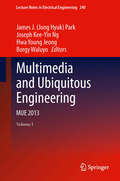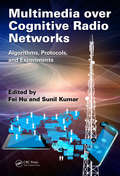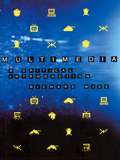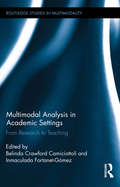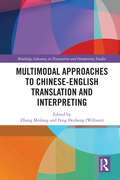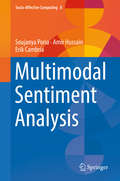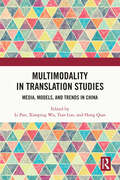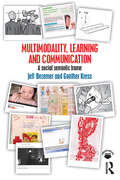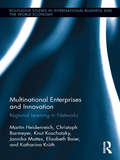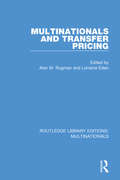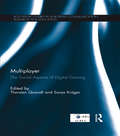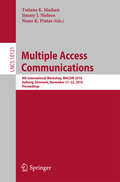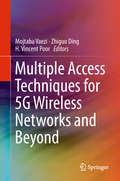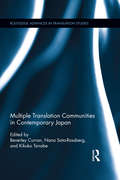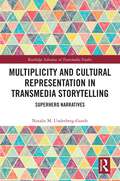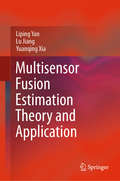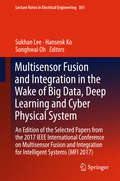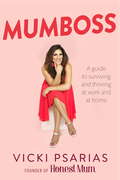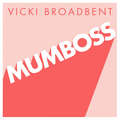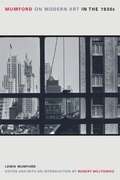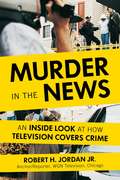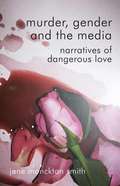- Table View
- List View
Multimedia and Ubiquitous Engineering
by James J. Park Hwa Young Jeong Borgy Waluyo Joseph Kee-Yin NgThe new multimedia standards (for example, MPEG-21) facilitate the seamless integration of multiple modalities into interoperable multimedia frameworks, transforming the way people work and interact with multimedia data. These key technologies and multimedia solutions interact and collaborate with each other in increasingly effective ways, contributing to the multimedia revolution and having a significant impact across a wide spectrum of consumer, business, healthcare, education, and governmental domains. Multimedia and Ubiquitous Engineering provides an opportunity for academic and industry professionals to discuss recent progress in the area of multimedia and ubiquitous environment including models and systems, new directions, novel applications associated with the utilization and acceptance of ubiquitous computing devices and systems.
Multimedia over Cognitive Radio Networks: Algorithms, Protocols, and Experiments
by Sunil Kumar Fei HuWith nearly 7 billion mobile phone subscriptions worldwide, mobility and computing have become pervasive in our society and business. Moreover, new mobile multimedia communication services are challenging telecommunication operators. To support the significant increase in multimedia traffic-especially video-over wireless networks, new technological
Multimedia: A Critical Introduction
by Richard WiseMultimedia: A Critical Introduction is a comprehensive guide to the new media form which has resulted from the application of computer technology to existing techniques of broadcasting and telecommunications transmission. The rapid growth of multimedia technologies such as the internet, e-mail and digital television holds the promise of a new 'information age' in which individual tastes are catered for, citizens become better informed, and new wealth is created. But are new media technologies really designed to achieve these utopian aims?Multimedia: a critical introduction provides a historical, cultural and political context to the development of multimedia, as both a technology and a concept. Individual chapters address:* the origins of multimedia in the unlikely interaction between the military and 1960s counter-culture: how the phenomenal US budgets allocated to US military research resulted in the microchip, and why the efforts of counter-culture computer hobbyists evolved into a multi-billion dollar industry.*the wider democratic and cultural implications of multimedia in the wake of the deregulation of the media industries by 'new right' governments in the 1980s, which has led to the domination of the media by transnational conglomerates.* issues of privacy and censorship in relation to new media, including discussion of cryptography, electronic surveillance, and attempts to regulate material such as pornography on the internet.* the use of digital technology to create special effects in feature films.
Multimodal Analysis in Academic Settings: From Research to Teaching (Routledge Studies in Multimodality)
by Belinda Crawford Camiciottoli Inmaculada Fortanet-GómezThis volume presents innovative research on the multimodal dimension of discourse specific to academic settings, with a particular focus on the interaction between the verbal and non-verbal in constructing meaning. Contributions by experienced and emerging researchers provide in-depth analyses in both research and teaching contexts, and consider the ways in which multimodal strategies can be leveraged to enhance the effectiveness of academic communication. Contributors employ both quantitative and qualitative analytical methods, and make use of state-of-the-art software for analyzing multimodal features of discourse. The chapters in the first part of the volume focus on the multimodal features of two key research genres: conference presentations and plenary addresses. In the second part, contributors explore the role of multimodality in the classroom through analyses of both instructors’ and students’ speech, as well as the use of multimodal materials for more effective learning. The research presented in this volume is particularly relevant within the context of globalized higher education, where participants represent a wide range of linguistic and cultural backgrounds. Multimodal Analysis in Academic Settings contributes to an emerging field of research with importance to an increasing number of academics and practitioners worldwide.
Multimodal Approaches to Chinese-English Translation and Interpreting (Routledge Advances in Translation and Interpreting Studies)
by Zhang Meifang Feng DezhengNowadays, discourse analysis deals with not only texts but also paratexts and images, so do translation and interpreting studies. Therefore, the concept of "multimodality" has become an increasingly important topic in subject areas of linguistics, discourse analysis and translation studies. However, up to now, not much research has been done systematically on multimodal factors in translation and interpreting, even less in exploring research models or methodologies for multimodal analysis in translation and interpreting. This book aims to introduce and apply different theories of the multimodal discourse analysis to the study of translations, with case studies on Chinese classics such as the Monkey King, Mulan and The Art of War, as well as on interpretations of up-to-date issues including the Chinese Bell and Road Initiative and Macao tourism. The chapters reflect the first attempts to apply multimodal approaches to translation and interpreting with a special focus on Chinese-English translations and interpreting. They provide new understandings of transformations in the multimodal translation process and useful reference models for researchers who are interested in doing research of similar kind, especially for those who are interested in looking into translations related to Chinese language, literature and culture.
Multimodal Sentiment Analysis (Socio-Affective Computing #8)
by Amir Hussain Erik Cambria Soujanya PoriaThis latest volume in the series, Socio-Affective Computing, presents a set of novel approaches to analyze opinionated videos and to extract sentiments and emotions. Textual sentiment analysis framework as discussed in this book contains a novel way of doing sentiment analysis by merging linguistics with machine learning. Fusing textual information with audio and visual cues is found to be extremely useful which improves text, audio and visual based unimodal sentiment analyzer. This volume covers the three main topics of: textual preprocessing and sentiment analysis methods; frameworks to process audio and visual data; and methods of textual, audio and visual features fusion. The inclusion of key visualization and case studies will enable readers to understand better these approaches. Aimed at the Natural Language Processing, Affective Computing and Artificial Intelligence audiences, this comprehensive volume will appeal to a wide readership and will help readers to understand key details on multimodal sentiment analysis.
Multimodality in Translation Studies: Media, Models, and Trends in China
by Hong Qian Tian Luo Li Pan Xiaoping WuFocusing on multimodality in translation studies, this edited volume provides insights into the trends and practices of multimodal translation in a variety of media. Divided into four main themes, the book explores audiovisual translation in digital media, multimodal translation of Chinese classics, multimodal design in website translation, and the use of paratexts in conference interpreting. Contributors draw on a diverse range of methods and theoretical models, including systemic functional multimodal discourse analysis, narrative theory, Skopos-functional theory, multimodal analysis of digital discourse, and corpus-based multimodal analysis. It covers important topics in media translation, ranging from emerging multimodal translation models to multimodal creativity in interlingual subtitling for social media and identity construction in the multimodal translation of food advertising. Through robust empirical studies, the book aims to shed light on the methodological development of multimodal translation in different media forms, including social media, websites, on-site interactions and books. The title will be of great value to scholars and students of linguistics, translation studies, multimodal discourse analysis and digital media.
Multimodality, Learning and Communication: A social semiotic frame
by Gunther Kress Jeff BezemerThis state-of-the-art account of research and theorizing brings together multimodality, learning and communication through detailed analyses of signmakers and their meaning-making in museums, hospitals, schools and the home environment. By analyzing video recordings, photographs, screenshots and print materials, Jeff Bezemer and Gunther Kress go well beyond the comfortable domains of traditional sites of (social) semiotic and multimodal research. They steer away from spurious invention and naming of ever more new and exciting domains, focusing instead on fundamentals in assembling a set of tools for current tasks: namely, describing and analyzing learning and communication in the contemporary world as one integrated field. The theory outlined in the book is grounded in the findings of the authors' wide-ranging empirical investigations. Each chapter evaluates the work that is being done and has been done, challenging accepted wisdom and standing much of it on its head. With extensive illustrations and many examples presented to show the reach and applicability of the theory, this book is essential reading for all those working in multimodality, semiotics, applied linguistics and related areas. Images from the book are also available to view online at www.routledge.com/9780415709620/
Multinational Enterprises and Innovation: Regional Learning in Networks (Routledge Studies in International Business and the World Economy)
by Martin Heidenreich Katharina Krüth Christoph Barmeyer Knut Koschatzky Jannika Mattes Elisabeth BaierThe crucial actors of a global knowledge-based economy are multinational enterprises (MNEs). MNEs depend on the embeddedness in an institutional framework; their competitive advantage depends on the cross-border utilisation of regional and national capabilities. The innovativeness of a company is therefore based also on regional innovation systems. Multinational Enterprises and Innovation contributes to a better understanding of the interconnectedness between organisational and regional learning. On the basis of case studies in Germany and France, this volume investigates how MNEs cope with technical, economic and institutional uncertainties by drawing upon the complementary strengths of organisational and regional networks in national and European contexts. The book links two theoretical debates which are currently still largely disconnected -- the debate on learning processes in MNEs and the debate on the regional bases of innovativeness and competitiveness -- answering the question of how the internationalisation of R&D is reconciled with regional competences.
Multinationals and Transfer Pricing (Routledge Library Editions: Multinationals)
by Alan M. Rugman and Lorraine EdenOne of the reasons for the success of multinational enterprises in their ability to create in their supranational organisations "internal markets" which eliminate the imperfections of external world markets caused by tariffs on trade, restrictions on the flow of capital, information costs and so on. The method multinationals use to create and sustain internal markets is transfer pricing. Multinationals use to their advantage the difference between nominal accounting and real transfers from their head offices to a subsidiary in different countries to overcome transaction costs and restrictions on trade and capital flows. This book, first published in 1985, examines these and other aspects of multinationals’ use of transfer pricing. It puts forward original thinking and research findings by leading experts in this area. Empirical results are related to the activities of multinationals in less developed countries. This volume covers the economic theories of transfer pricing, accounting and fiscal practices and implications for government policies and regulations, and will be of interest to students of economics and business studies.
Multiplayer: The Social Aspects of Digital Gaming (Routledge Studies in European Communication Research and Education)
by Thorsten Quandt Sonja KrögerIn the past decade, digital games have become a widely accepted form of media entertainment, moving from the traditional 'core gamer' community into the mainstream media market. With millions of people now enjoying gaming as interactive entertainment there has been a huge increase in interest in social multiplayer gaming activities. However, despite the explosive growth in the field over the past decade, many aspects of social gaming still remain unexplored, especially from a media and communication studies perspective. Multiplayer: Social Aspects of Digital Gaming is the first edited volume of its kind that takes a closer look at the various forms of human interaction in and around digital games, providing an overview of debates, past and present. The book is divided into five sections that explore the following areas: Social Aspects of Digital Gaming Social Interactions in Virtual Worlds Online Gaming Co-located and Console Gaming Risks and Challenges of Social Gaming This engaging interdisciplinary book will appeal to upper level students, postgrads and researchers in games research, specifically those focusing on new media and digital games, as well as researchers in media studies and mass communication.
Multiple Access Communications
by Tatiana K. Madsen Jimmy J. Nielsen Nuno K. PratasThis book constitutes the proceedings of the 9th International Workshop on Multiple Access Communications, MACOM 2016, held in Aalborg, Denmark, in November 2016. The 10 full papers presented in this volume were carefully reviewed and selected from 12 submissions. They were organized in topical sections named: physical layer aspects; MAC layer aspects; and information theory.
Multiple Access Techniques for 5G Wireless Networks and Beyond
by H. Vincent Poor Mojtaba Vaezi Zhiguo DingThis book presents comprehensive coverage of current and emerging multiple access, random access, and waveform design techniques for 5G wireless networks and beyond. A definitive reference for researchers in these fields, the book describes recent research from academia, industry, and standardization bodies. The book is an all-encompassing treatment of these areas addressing orthogonal multiple access and waveform design, non-orthogonal multiple access (NOMA) via power, code, and other domains, and orthogonal, non-orthogonal, and grant-free random access. The book builds its foundations on state of the art research papers, measurements, and experimental results from a variety of sources.
Multiple Access Technology Towards Ubiquitous Networks: Overview and Efficient Designs
by Xiangming Li Kai Yang Jianping An Neng YeThis book investigates the multiuser communication and its key technology—multiple access technology, as well as transceiving design methods. Multiple access methods toward B5G and 6G currently allows the superposition transmissions of multiuser signals with controllable mutual interference. By deploying advanced multiuser detector, current technology significantly enhances the connectivity, improves the spectral efficiency and simplifies the signaling interactions. Considering that the major challenge of current multiple access technology is the design of transceiver due to the overlapped and distorted signals from multiple users, we analyze the promising candidate multiple access schemes and then develop some sights on how to formulate the transmit signals and how to achieve efficient symbol recovery. Specifically, the incorporation of constellation rotation, rate splitting and deep learning techniques in enhancing the transmission efficiency of multiple access technology are considered.
Multiple Translation Communities in Contemporary Japan (Routledge Advances in Translation and Interpreting Studies)
by Nana Sato-Rossberg Beverley Curran Kikuko TanabeMultiple Translation Communities in Contemporary Japan offers a collection of essays that (1) deepens the understanding of the cultural and linguistic diversity of communities in contemporary Japan and how translation operates in this shifting context and circulates globally by looking at some of the ways it is theorized and approached as a significant social, cultural, or political practice, and harnessed by its multiple agents; (2) draws attention to the multi-platform translations of cultural productions such as manga, which are both particular to and popular in Japan but also culturally influential and widely circulated transnationally; (3) poses questions about the range of roles translation has in the construction, performance, and control of gender roles in Japan, and (4) enriches Translation Studies by offering essays that problematize critical notions related to translation. In short, the essays in this book highlight the diversity and ubiquity of translation in Japan as well as the range of methods being used to understand how it is being theorized, positioned, and practiced.
Multiplicity and Cultural Representation in Transmedia Storytelling: Superhero Narratives (Routledge Advances in Transmedia Studies)
by Natalie Underberg-GoodeThis book explores the relationship between multiplicity and representation of non-European and European-American cultures, with a focus on comics and superheroes. The author employs a combination of research methodologies, including close reading of transmedia texts and interviews with transmedia storytellers and audiences, to better understand the way in which diverse cultures are employed as agents of multiplicity in transmedia narratives. The book addresses both commercial franchises such as superhero narratives, as well as smaller indie projects, in an attempt to elucidate the way in which key cultural symbols and concepts are utilized by writers, designers, and producers, and how these narrative choices affect audiences – both those who identify as members of the culture being represented and those who do not. Case studies include fan fiction based on Marvel’s Black Panther (2018), fan fiction and art created for the Moana (2016) and Mulan (2020) films, and creations by both U.S.-based and international indie comics artists and writers. This book will appeal to scholars and students of new media, narrative theory, cultural studies, sociocultural anthropology, folkloristics, English/literary studies, and popular culture, transmedia storytelling researchers, and both creators and fans of superhero comics.
Multisensor Fusion Estimation Theory and Application
by Yuanqing Xia Lu Jiang Liping YanThis book focuses on the basic theory and methods of multisensor data fusion state estimation and its application. It consists of four parts with 12 chapters. In Part I, the basic framework and methods of multisensor optimal estimation and the basic concepts of Kalman filtering are briefly and systematically introduced. In Part II, the data fusion state estimation algorithms under networked environment are introduced. Part III consists of three chapters, in which the fusion estimation algorithms under event-triggered mechanisms are introduced. Part IV consists of two chapters, in which fusion estimation for systems with non-Gaussian but heavy-tailed noises are introduced. The book is primarily intended for researchers and engineers in the field of data fusion and state estimation. It also benefits for both graduate and undergraduate students who are interested in target tracking, navigation, networked control, etc.
Multisensor Fusion and Integration in the Wake of Big Data, Deep Learning and Cyber Physical System: An Edition of the Selected Papers from the 2017 IEEE International Conference on Multisensor Fusion and Integration for Intelligent Systems (MFI 2017) (Lecture Notes in Electrical Engineering #501)
by Sukhan Lee Hanseok Ko Songhwai OhThis book includes selected papers from the 13th IEEE International Conference on Multisensor Integration and Fusion for Intelligent Systems (MFI 2017) held in Daegu, Korea, November 16–22, 2017. It covers various topics, including sensor/actuator networks, distributed and cloud architectures, bio-inspired systems and evolutionary approaches, methods of cognitive sensor fusion, Bayesian approaches, fuzzy systems and neural networks, biomedical applications, autonomous land, sea and air vehicles, localization, tracking, SLAM, 3D perception, manipulation with multifinger hands, robotics, micro/nano systems, information fusion and sensors, and multimodal integration in HCI and HRI. The book is intended for robotics scientists, data and information fusion scientists, researchers and professionals at universities, research institutes and laboratories.
Mumboss: The Honest Mum's Guide to Surviving and Thriving at Work and at Home
by Vicki BroadbentChosen by the Independent as one of the 10 best business books written by women'Vicki is one inspirational mumboss, who shares her secrets to juggling a thriving business with raising a family in this entertaining and empowering read!' Una Healy'Ideal for going back to work without losing your mind . . . a no-nonsense guide to navigating the transition' Marie Claire 'If ever there is a person who has shown just how successful you can be online whilst also being an amazing parent it is Vicki. Read, learn and follow. A brilliant book from an inspirational mother'. Natasha Courtenay-Smith, author of The Million Dollar BlogIn Mumboss, Vicki Psarias, founder of HonestMum.com, shares her #mumboss manifesto for surviving and thriving at work and at home. Vicki writes about everything from juggling work and family, to regaining your confidence after having a baby and battling imposter syndrome.An award-winning blogger and vlogger, in this book Vicki shares how to turn your passions into a business that suits the modern mum's lifestyle. Mumboss is full of practical advice, tips and tricks to help fellow #mumbosses build their own business or return to work, while creating a personal brand and learning how to market yourself.Vicki's funny, fresh approach to life and work as a mum has brought her a loyal fanbase and a brilliantly successful business: her blog Honest Mum is one of the UK's most popular parenting and lifestyle sites, and the blog combined with Vicki's social channels has an average monthly reach of 3 million. A Lean In for the blogging and vlogging generation, Mumboss is an essential book for all parents, whether they are returning to work or looking to start a new career, as well as anyone looking to build their brand or business online.'A must-read for the modern Mum; particularly one who has aspirations to build her own business. I wish I had been able to read it three years ago!' Katie Massie-Taylor, Co-Founder, Mush
Mumboss: The Honest Mum's Guide to Surviving and Thriving at Work and at Home
by Vicki BroadbentChosen by the Independent as one of the 10 best business books written by women'Vicki is one inspirational mumboss, who shares her secrets to juggling a thriving business with raising a family in this entertaining and empowering read!' Una Healy'Ideal for going back to work without losing your mind . . . a no-nonsense guide to navigating the transition' Marie Claire 'If ever there is a person who has shown just how successful you can be online whilst also being an amazing parent it is Vicki. Read, learn and follow. A brilliant book from an inspirational mother'. Natasha Courtenay-Smith, author of The Million Dollar BlogIn Mumboss, Vicki Psarias, founder of HonestMum.com, shares her #mumboss manifesto for surviving and thriving at work and at home. Vicki writes about everything from juggling work and family, to regaining your confidence after having a baby and battling imposter syndrome.An award-winning blogger and vlogger, in this book Vicki shares how to turn your passions into a business that suits the modern mum's lifestyle. Mumboss is full of practical advice, tips and tricks to help fellow #mumbosses build their own business or return to work, while creating a personal brand and learning how to market yourself.Vicki's funny, fresh approach to life and work as a mum has brought her a loyal fanbase and a brilliantly successful business: her blog Honest Mum is one of the UK's most popular parenting and lifestyle sites, and the blog combined with Vicki's social channels has an average monthly reach of 3 million. A Lean In for the blogging and vlogging generation, Mumboss is an essential book for all parents, whether they are returning to work or looking to start a new career, as well as anyone looking to build their brand or business online.'A must-read for the modern Mum; particularly one who has aspirations to build her own business. I wish I had been able to read it three years ago!' Katie Massie-Taylor, Co-Founder, Mush
Mumboss: The Honest Mum's Guide to Surviving and Thriving at Work and at Home
by Vicki PsariasChosen by the Independent as one of the 10 best business books written by women'Vicki is one inspirational mumboss, who shares her secrets to juggling a thriving business with raising a family in this entertaining and empowering read!' Una Healy'Ideal for going back to work without losing your mind . . . a no-nonsense guide to navigating the transition' Marie Claire 'If ever there is a person who has shown just how successful you can be online whilst also being an amazing parent it is Vicki. Read, learn and follow. A brilliant book from an inspirational mother'. Natasha Courtenay-Smith, author of The Million Dollar BlogIn Mumboss, Vicki Psarias, founder of HonestMum.com, shares her #mumboss manifesto for surviving and thriving at work and at home. Vicki writes about everything from juggling work and family, to regaining your confidence after having a baby and battling imposter syndrome.An award-winning blogger and vlogger, in this book Vicki shares how to turn your passions into a business that suits the modern mum's lifestyle. Mumboss is full of practical advice, tips and tricks to help fellow #mumbosses build their own business or return to work, while creating a personal brand and learning how to market yourself.Vicki's funny, fresh approach to life and work as a mum has brought her a loyal fanbase and a brilliantly successful business: her blog Honest Mum is one of the UK's most popular parenting and lifestyle sites, and the blog combined with Vicki's social channels has an average monthly reach of 3 million. A Lean In for the blogging and vlogging generation, Mumboss is an essential book for all parents, whether they are returning to work or looking to start a new career, as well as anyone looking to build their brand or business online.'A must-read for the modern Mum; particularly one who has aspirations to build her own business. I wish I had been able to read it three years ago!' Katie Massie-Taylor, Co-Founder, Mush
Mumford on Modern Art in the 1930s
by Lewis MumfordAlthough Lewis Mumford is widely acknowledged as the seminal American critic of architecture and urbanism in the twentieth century, he is less known for his art criticism.
Murder and Media in the New Rome
by Thomas SimpsonAn insightful look into the origins of modern Italian media culture by examining a sensational crime and trial that took place in Rome in the late 1870s, when a bloody murder triggered a national spectacle that became the first great media circus in the new nation of Italy, crucially shaping the young state's public sphere and image of itself.
Murder in the News: An Inside Look at How Television Covers Crime
by Robert H. JordanA veteran, Emmy Award-winning TV news anchor provides a unique insider glimpse into the newsroom revealing how murder cases are selected for TV coverage.Television news anchor Robert Jordan Jr. draws from forty-seven years of news experiences to provide an eye-opening look at how news programs decide which murders to cover and which ones to ignore. Jordan takes readers behind the scenes into the big city newsrooms of Chicago. Here split-second decisions are made on where to send limited resources when dozens of shootings and several murders are occurring on a daily basis.Using interviews from decision makers--such as assignment editors and producers--who work daily in the trenches of working newsrooms, the reader learns how they decide where to send reporters; when to dispatch live trucks; and how the stories will be treated as they are placed in the news programming. Why will one story get "breaking news" banners and be placed at the top of the broadcast while others may not make the air at all or may be given casual mention in later segments?Additionally, Jordan reveals the results of a ground-breaking questionnaire sent to producers and assignment editors at Chicago television stations to assess their rationales for covering murder stories the way they do. Finally, he examines how the explosion of social media platforms has changed the dynamic of reporting the news and why murders are the perfect stories for television, as news organizations struggle to survive.
Murder, Gender and the Media
by Jane Monckton SmithThis volume is a shocking insight into the way the idea of romantic love can justify and excuse the killing of women by their spouses and partners, and lead to sympathy and reduced prison sentences for the killers. The author explores how stories of domestic homicide and love are told in the news, by the police, and in the courts, drawing from the reporting of 72 cases which happened in just one twelve month period. The findings make compelling reading and are important in understanding how we respond to domestic abuse and violence more generally, making clear the need to listen to victims more closely both before and after death. The book also includes a personal account of the aftermath of a double murder which was pivotal to the introduction of Domestic Homicide Reviews in the UK in April 2011.
